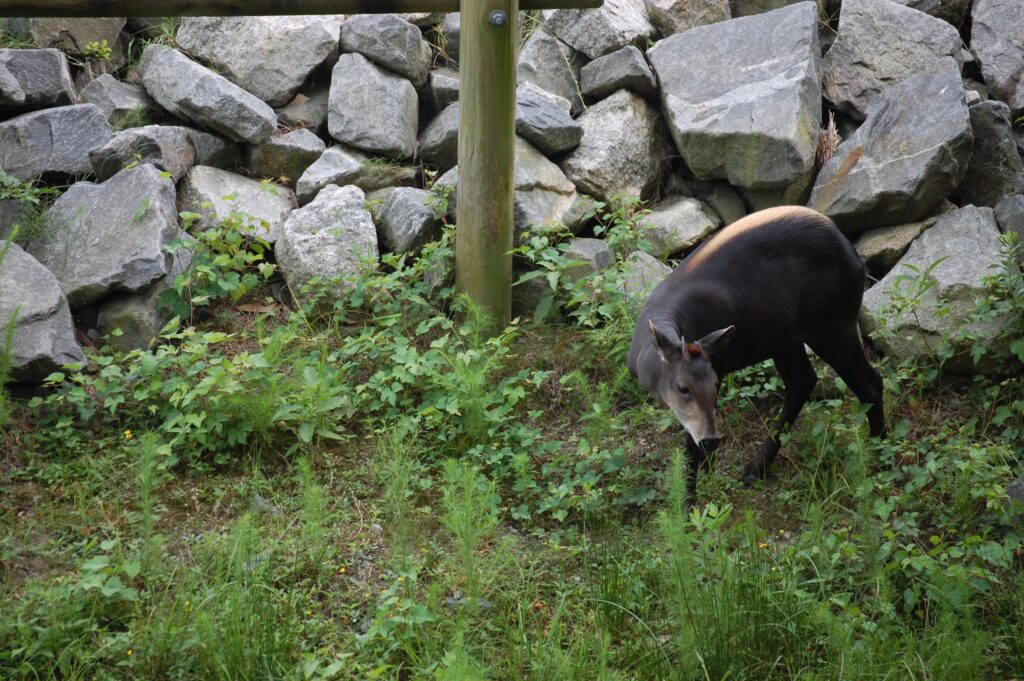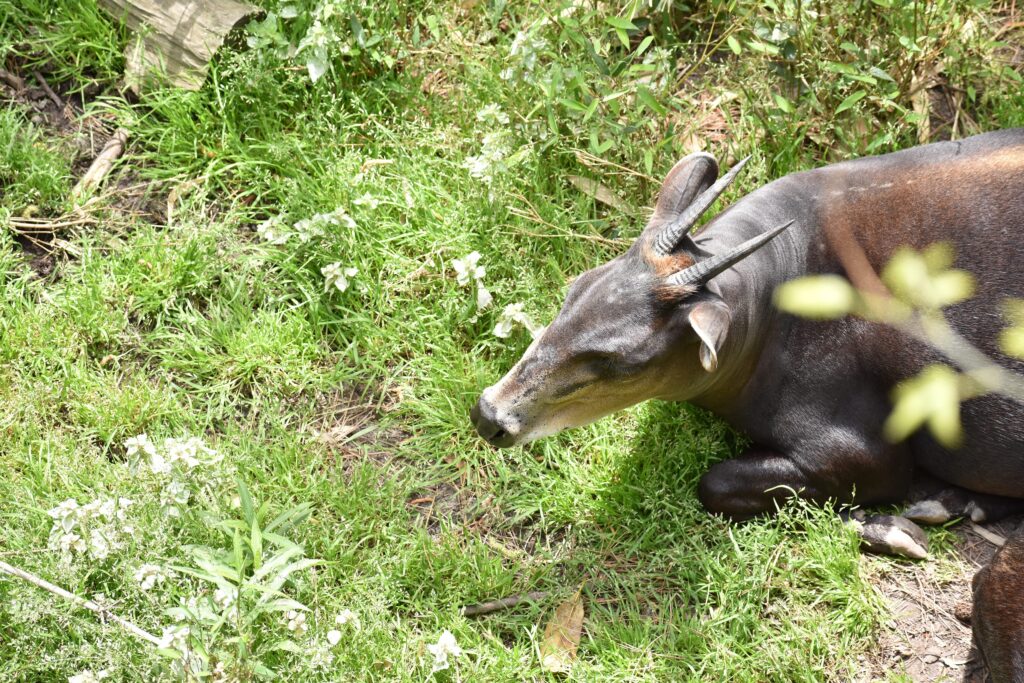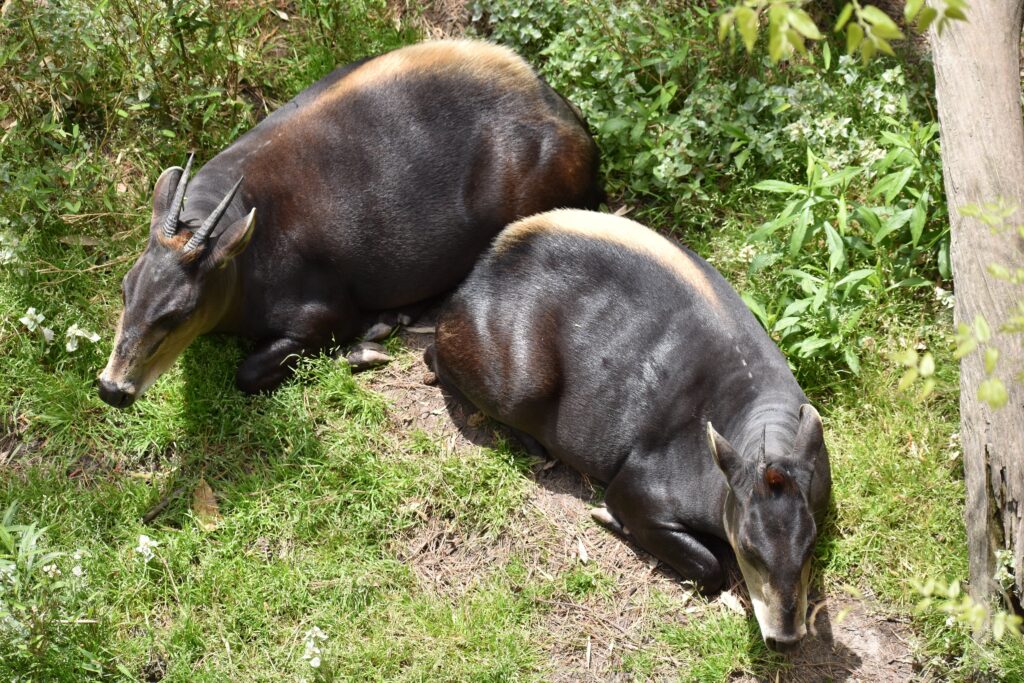Mellow Yellow
What is a duiker? “Duiker” is most likely an unfamiliar term in your animal vocabulary but fear not, we can clarify what this animal is and even introduce you to one of the 22 different species, specifically the Yellow-backed duikers found living at the Virginia Zoo. Let’s dive right in – pun intended.
The word duiker comes from an Afrikans language and translates to “diver”. These mammals are notorious for “diving” for cover in thick brush when threatened. Duikers are small to medium-sized antelope. Your first question may be: are antelope the same as deer? The answer is absolutely not. The main difference between the two types of animals are their antlers and horns. Deer have antlers that grow, are shed and regrow annually, while antelope have horns that are permanent, however they can be accidentally broken off and will never regrow back. Both male and female duikers have short cylindrical horns which are ribbed at the base, and for Yellow-backed duikers specifically, a tuft of reddish-brown hair sits between the horns.
Duikers are primarily frugivorous, which means they feed mainly on fruit; however, they will eat a variety of other foods in small quantities, including flowers, roots, rotting wood, fungi and some insects, particularly ants. Yellow-backed duikers are the largest of all the duikers, growing from four to just over six feet in length and weighing 99 to 176 pounds. This particular species earned its name from the small triangular patch of yellow fur found on the back. This patch, along with their blackish-brown coat, aids in camouflaging in their habitat. Yellow-baked duikers are found in forests, ranging from south-western Senegal through all West African countries. This species is the most common of the duikers, however their habitats have been diminished and the population has been reduced to low numbers or eliminated completely by forest destruction and encroachment of human settlements, coupled with uncontrolled hunting for bushmeat. The species is now listed as near threatened with extinction by the International Union for Conservation of Nature’s Red List, with a total population estimated at around 160,000 individuals.
The Virginia Zoo is currently home to two Yellow-backed duikers, mother-daughter duo Dot and Asterisk, who as you can guess, were named after punctuation marks. 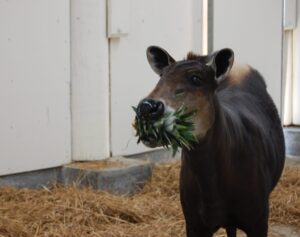
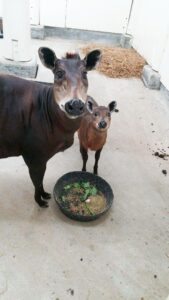 Mom dot is ten years old, just celebrating her birthday on January 4. She was born at the Houston Zoo and was moved to the Virginia Zoo in 2013. Keepers say Dot is very skittish, but often enjoys interactions with Keepers, especially when food is offered. Fruit, especially mango and strawberries are her favorites, but she also receives herbivore grain, and a variety of fresh browse and produce as part of her diet. She enjoys spending her time enjoying snuggly straw beds as enrichment. Dot is also an excellent mother, giving birth to four calves including her exhibit mate, Asterisk. Asterisk was born at the Virginia Zoo on January 18, 2017 and is four years old. Asterisk enjoys the same diet as mom, but seems to enjoy fruits and browse the most. Like her mother, dot is also skittish, but has occasionally made an appearance during giraffe behind-the-scenes tours, where she will try to indulge in the food being offered to her taller exhibit mates. She also enjoys laying in the sun on quiet days and lounging around indoors with ostrich Jack. The pair can be seen in the same exhibit as the Masai giraffes, ostrich and Southern ground hornbills, however they can be elusive, often finding shelter indoors or in the thick foliage around the perimeter of the Africa – Okavango Delta exhibit.
Mom dot is ten years old, just celebrating her birthday on January 4. She was born at the Houston Zoo and was moved to the Virginia Zoo in 2013. Keepers say Dot is very skittish, but often enjoys interactions with Keepers, especially when food is offered. Fruit, especially mango and strawberries are her favorites, but she also receives herbivore grain, and a variety of fresh browse and produce as part of her diet. She enjoys spending her time enjoying snuggly straw beds as enrichment. Dot is also an excellent mother, giving birth to four calves including her exhibit mate, Asterisk. Asterisk was born at the Virginia Zoo on January 18, 2017 and is four years old. Asterisk enjoys the same diet as mom, but seems to enjoy fruits and browse the most. Like her mother, dot is also skittish, but has occasionally made an appearance during giraffe behind-the-scenes tours, where she will try to indulge in the food being offered to her taller exhibit mates. She also enjoys laying in the sun on quiet days and lounging around indoors with ostrich Jack. The pair can be seen in the same exhibit as the Masai giraffes, ostrich and Southern ground hornbills, however they can be elusive, often finding shelter indoors or in the thick foliage around the perimeter of the Africa – Okavango Delta exhibit.
